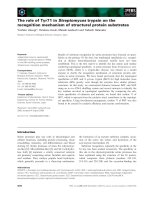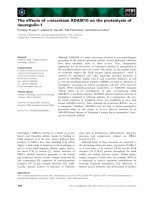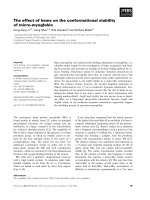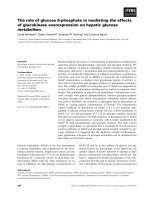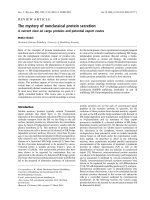báo cáo khoa học: " The World Summit on Sustainable Development: reaffirming the centrality of health" docx
Bạn đang xem bản rút gọn của tài liệu. Xem và tải ngay bản đầy đủ của tài liệu tại đây (212.45 KB, 6 trang )
BioMed Central
Page 1 of 6
(page number not for citation purposes)
Globalization and Health
Open Access
Short report
The World Summit on Sustainable Development: reaffirming the
centrality of health
Yasmin von Schirnding*
Address: Sustainable Development and Healthy Environments Cluster World Health Organisation Geneva Switzerland
Email: Yasmin von Schirnding* -
* Corresponding author
Abstract
The World Summit on Sustainable Development (WSSD) was held in Johannesburg in 2002 to
review progress since the Rio conference in 1992, and to agree a new global deal on sustainable
development. Unlike its predecessor, it was primarily concerned with implementation rather than
with new treaties and targets, although a number of new targets were agreed, for example one on
sanitation. Failure to agree a target on renewable energy was regarded as a major disappointment
of the conference. While relatively modest in its achievements, and with difficulties in achieving
consensus in key areas such as energy, trade, finance and globalisation, WSSD nevertheless
succeeded in placing sustainable development back on the political agenda, giving new impetus, in
particular to the environment and development needs of Africa, with a strong focus on local issues
like household energy, water and sanitation. Health was singled out as one of five priority areas,
along with water, energy, agriculture and biodiversity, and was devoted a separate chapter in the
resulting Plan of Implementation, which highlighted a range of environmental health issues as well
as issues relating to health services, communicable and non-communicable diseases. A number of
new partnerships were formed at WSSD, including the Healthy Environments for Children Alliance
(HECA) launched by WHO, which will form an important platform for implementation. The
Commission on Sustainable Development has been designated main responsibility for monitoring
and follow up, with its programme of work reorganised to focus on thematic clusters of issues.
From the perspective of health, WSSD must be seen as a reaffirmation of the central place of health
on the sustainable development agenda, and in the broader context of a process which began in
Rio and was given added impetus with the Monterrey Financing for Development conference and
the World Trade Organisation meeting held in Doha. Translating policies into action at all levels-
global to local – remains the single biggest challenge in the years that lie ahead.
The world summit on sustainable development:
reaffirming the centrality of health
It will be years before we can assess the true impact of the
world's largest UN Summit, which brought together gov-
ernments, the private sector and civil society to agree on a
new global deal on sustainable development. Over one
hundred Heads of State and Governments addressed the
World Summit on Sustainable Development (WSSD)
held in August 2002 in Johannesburg, South Africa [1],
and over twenty two thousand people participated,
including more than ten thousand delegates and eight
thousand representatives of NGOs and civil society. It had
Published: 10 May 2005
Globalization and Health 2005, 1:8 doi:10.1186/1744-8603-1-8
Received: 08 January 2005
Accepted: 10 May 2005
This article is available from: />© 2005 von Schirnding; licensee BioMed Central Ltd.
This is an Open Access article distributed under the terms of the Creative Commons Attribution License ( />),
which permits unrestricted use, distribution, and reproduction in any medium, provided the original work is properly cited.
Globalization and Health 2005, 1:8 />Page 2 of 6
(page number not for citation purposes)
as its key aims to review progress since the UN Conference
on Environment and Development held in Rio in 1992
and to recommend measures to strengthen implementa-
tion of Agenda 21 (the global programme of action on
sustainable development) and other outcomes of the Rio
conference.
The term sustainable development, as originally defined
by the 1987 World Commission on Environment and
Development [2] (the "Brundtland Commission") was
meant to entail "development that meets the needs of the
present without compromising the ability of future gener-
ations to meet their own needs". It was coined as part of
an effort to bring environmental issues into the main-
stream of development, recognizing that in order to
address the escalating problems related to the environ-
ment, the root causes which lay in the broader develop-
ment process and the global economic system needed to
be addressed. As originally articulated "sustainable" cap-
tured the environmental issues (assumed to centre on the
needs of future generations) while "development" cap-
tured the economic/poverty issues (assumed to centre on
the needs of the present generation). The concept has since
been broadened, in recognition of the non-environmental
aspects of sustainability, and the non-economic aspects of
development [3].
In some ways we are only now beginning to judge the suc-
cess of the Rio conference held ten years earlier. In com-
parison with the WSSD, which was largely concerned with
implementation rather than with new visions, treaties and
agreements, Rio led to a dramatic new paradigm shift in
thinking on sustainable development, and to new legally
binding agreements such as those concerned with biodi-
versity, and with climate change. Over the ensuing years
however, there has occurred a dwindling in high-level
political interest and engagement with sustainable devel-
opment issues.
While WSSD in comparison with Rio was more modest in
its immediate achievements, it nevertheless resulted in
placing sustainable development back on the political
and public agenda. New impetus was given to global
action to protect the environment and fight poverty, with
the development needs of Africa identified for special
attention and support by the international community. A
significant departure from Rio was a greater concern with
social and economic issues-perhaps not surprising given
that the conference was hosted by South Africa. There was
also a stronger emphasis on local, as opposed to global,
issues – for example with issues such as household energy,
water and sanitation, rather than with the global prob-
lems associated with climate change which received so
much attention in Rio.
The major outcomes of WSSD included a negotiated Plan
of Implementation, a Political Declaration and a number
of implementation partnerships and initiatives [1]. New
targets and agreements were negotiated in a number of
important areas, for example in sanitation. Previous
agreements such as those relating to the achievement of
the Millenium Development Goals [4], were also reaf-
firmed, making the Johannesburg Plan of Implementa-
tion a somewhat eclectic mix of new and past agreements
and affirmations, albeit with many important implica-
tions for health.
One of the difficulties however was that so many of the
key global issues – AIDS, biodiversity, climate change,
trade – had their own conference processes, treaty and
other mechanisms in place, such that WSSD could only
serve to reaffirm these rather than cut new ground. The
preparatory meetings preceding Johannesburg were char-
acterized by difficult negotiations and attempts to achieve
consensus on key aspects of the plan, particularly on
energy, trade, finance and globalization. While consensus
was eventually achieved in Johannesburg, contentious
issues were often solved by falling back on previously
agreed positions.
A separate chapter was included on globalization in the
Plan of Implementation (strongly pushed for by the G77/
China), which emphasized the need for successful com-
pletion of the Doha round of trade negotiations and the
implementation of the Monterrey Consensus negotiated
at the International Conference on Financing for Develop-
ment held in Monterrey, Mexico. In addition, the final
chapter dealing with means of implementation addressed
also health-related commitments related to trade. Issues
of contention included the mobilization of financial
resources, and the EUs agricultural subsidies. Critics char-
acterized the failure to go beyond Doha to reduce trade-
distorting energy and agricultural subsidies in the rich
countries as a shortcoming of the summit.
The issue of setting a time-bound target to reverse the
trend in natural resource degradation caused disagree-
ment among countries, as did references to the precau-
tionary principle and the ecosystem approach, and the
principle of "Common but Differentiated Responsibili-
ties" agreed to in Rio. Other issues which were controver-
sial included debate about the need for stronger
governance at the international and national levels (the
former emphasized by developing countries and the latter
by developed countries), the role of the UN in follow up
to WSSD, partnerships and their possible modalities, and
the relationship between human rights and environmen-
tal protection.
Globalization and Health 2005, 1:8 />Page 3 of 6
(page number not for citation purposes)
Centrality of Health
A significant departure from Rio was that health issues fea-
tured centrally in WSSD, reflecting increased recognition
of health as a resource for, and as an indicator of, sustain-
able development. Already in 1992 the Rio Declaration
stated that "Human beings are at the centre of concerns
for sustainable development. They are entitled to a
healthy and productive life in harmony with nature." This
stressed the important interlinkages between the social,
economic and environmental pillars of sustainable devel-
opment, all of which are underpinned by good health.
Further, Chapter 6 of Agenda 21 emphasized the funda-
mental commitment within sustainable development to
"protecting and promoting human health" [5].
At the WSSD there was a greater emphasis on develop-
ment sectors, and health was singled out by the UN Secre-
tary General as one of five priority issues, in what became
known as the "WEHAB" initiative, with emphasis on
water, energy, health, agriculture and biodiversity [6,7].
Health was devoted a separate chapter in the negotiated
Plan of Implementation [8], and health issues permeated
the text throughout. A key message in the wide ranging
health agenda at WSSD was that sustainable development
cannot be achieved where there is a high prevalence of
debilitating illnesses, and the health of the population
cannot be maintained without a healthy environment.
Particular emphasis was placed on health issues in rela-
tion to environment and poverty concerns. At least a quar-
ter of the global burden of disease can be attributed to
environmental factors, many of them poverty-related. The
Johannesburg agenda reflected a major shift in recent
thinking which has occurred regarding the role of health
in poverty reduction and development. Health is far more
central to poverty reduction than previously thought, and
that realization is now beginning to shape national and
global policies [9].
While there were no major breakthroughs in health nor
dramatic new agreements reached, a key aspect of signifi-
cance was recognition of the importance of health in the
context of environment, water, energy, agriculture, biodi-
versity and other issues. Indeed the conference called for a
stronger emphasis on health and environment linkages –
a move initiated by the Canadians with strong backing
from WHO and UNEP.
Environmental Health Issues
Improving access to safe water, sanitation, clean air,
improved waste management and sound management of
chemicals were among the key issues which received spe-
cial attention in Johannesburg. Of particular note was the
call for increasing access to sanitation to improve human
health and reduce infant and child mortality, prioritising
water and sanitation in national sustainable development
strategies and poverty reduction strategies where they
exist. A new target was eventually agreed, namely to halve
by the year 2015 the proportion of people who do not
have access to basic sanitation. This new target comple-
ments the Millenium Development Goal on access to safe
drinking water, and was the subject of much acrimonious
debate.
Another important agreement was to aim, by 2020, to use
and produce chemicals in ways that lead to the minimisa-
tion of significant adverse effects on human health and
the environment taking into account the precautionary
approach. Also called for was the promotion of reduction
of risks posed by heavy metals that are harmful to human
health and the environment.
An agreement to diversify energy supply and substantially
increase the global share of renewable energy sources with
the objective of increasing its contribution to total energy
supply was significant (especially for its health implica-
tions), even though the Summit failed to reach agreement
on a specific time-bound target. There was also an agree-
ment to improve access to reliable and affordable energy
services for sustainable development and resources suffi-
cient to achieve the Millennium Development Goals.
Many countries however, viewed the failure to set targets
to increase the percentage of the world's power generated
by renewable energy sources as the Summit's most signif-
icant missed opportunity. The EU reacted by announcing
its intention to develop renewable energy sources accord-
ing to a set timetable with like-minded countries.
Other aspects of note were the call to enhance health edu-
cation (with the objective of achieving improved health
literacy on a global basis by 2010), and an emphasis on
capacity building to better assess health and environment
linkages. The need to strengthen occupational health pro-
grammes was highlighted, as was the necessity of reducing
air pollution exposures and related health impacts
(including through use of cleaner fuels, modern pollution
control techniques and reducing dependance on tradi-
tional fuel sources for cooking and heating), as well as
controlling lead exposure through eliminating lead in pet-
rol, paints and other sources of human exposure.
Communicable and Non-Communicable
Diseases
Reflecting the knowledge that has accumulated about
how ill-health creates and perpetuates poverty, triggering
a vicious cycle which hampers economic and social devel-
opment, the WSSD was also concerned with addressing
the main causes of avoidable death in low-income coun-
tries. These include HIV/AIDS, malaria, tuberculosis (TB),
childhood infectious diseases, maternal and perinatal
Globalization and Health 2005, 1:8 />Page 4 of 6
(page number not for citation purposes)
conditions, nutritional deficiencies and tobacco-related
illnesses. There was a strong reaffirmation of targets and
goals previously agreed, with emphasis on vulnerable
groups such as women and children. While AIDS received
due attention, it failed in many respects to be fully recog-
nised as a key development issue at WSSD. This was some-
what surprising given previous concerns that AIDS might
dominate the entire WSSD agenda.
A call was made to strengthen the capacity of health care
systems to deliver basic health services to all, aimed at
improving access to essential drugs, immunisation serv-
ices, vaccines and medical technology, improving mater-
nal and obstetric care and reproductive and sexual health.
These commitments were made with an emphasis on
meeting the Millenium Development Goals related to
health, including reducing maternal and child mortality.
One aspect of the health chapter that proved to be among
the most contentious of the Summit and which was of the
last to receive agreement on, related to references to
"health care and services". There was concern among
some that this could be construed to include abortion
services. Specific measures to combat and treat HIV/AIDS,
malaria, TB and other diseases were called for, with special
emphasis placed on the need to mobilise financial
resources and to support the Global Fund to Fight AIDS,
TB and Malaria.
While many countries continue to see their development
efforts hampered by the burden of communicable dis-
eases, at the same time they are faced with the rising inci-
dence of non-communicable diseases (NCDs). The rapid
rise of NCDs is also threatening economic and social
development as well as the lives and health of millions of
people. They represent a major health challenge to global
development in the coming century. Low- and middle-
income countries suffer the greatest impact, and the rapid
increase in these diseases disproportionately affects poor
and disadvantaged populations; contributing to widening
health gaps between and within countries. In this regard
Johannesburg called for programmes to combat non-
communicable diseases, mental health, injuries and vio-
lence and associated risk factors such as tobacco, alcohol,
unhealthy diets and lack of physical activity. In addition,
a ten-year framework of programmes in support of
regional and national initiatives to accelerate the shift
towards sustainable consumption and production (aimed
at promoting social and economic development within
the carrying capacity of ecosystems) was agreed, with
industrialised countries taking the lead.
The Call for Integrated Strategies and
Partnerships
Other aspects emphasised in the Plan of Implementation
included the need to integrate health concerns into strate-
gies, policies and programmes for poverty eradication and
sustainable development, implementation of the WHO
Health for All strategy [10], and creating more effective
national and regional policy responses to environmental
threats to human health, as well as encouraging health
promoting production and consumption policies.
Addressing the underlying determinants of health
through intersectoral efforts is key to ensuring sustained
health improvements and ecologically sustainable devel-
opment [11]. In this regard Johannesburg called for
increased action from the international community,
NGOs, the private sector and local communities to imple-
ment sustainable development objectives through part-
nerships and alliances at all levels- global to local. This
represented a major departure from previous UN confer-
ences and was strongly pushed by the US amid initial
opposition from many in the G77 bloc, who feared that
this would result in an abdication of responsibility away
from governments in favour of the private sector and
donor interests. Over 220 partnerships (including 16 in
health) with 235 million dollars in resources were identi-
fied in advance of the summit and around 60 partnerships
were announced during the Summit by a variety of coun-
tries, with many more announced outside of the formal
proceedings.
With health unquestionably recognised as an intersectoral
issue the health sector will have to seriously deliberate on
its changing role in this complex international landscape.
In many parts of the world intersectoral approaches and
partnerships have been successfully developed to tackle
particular diseases, both communicable (infectious) and
non-communicable [3]. Much progress has been made in
forging closer links between national health care and
other sectors, particularly through local and national
intersectoral health and development planning; increased
use of planning tools such as health impact assessment
procedures; integrated monitoring and surveillance sys-
tems; and improved health information systems and indi-
cators [3].
Many countries have instituted new policy and planning
frameworks over the past decade, and have developed
tools to make health and environment concerns an inte-
gral part of the planning process. For example at the
national level, National Environmental Health Action
Plans have been developed and at the local level, Local
Agenda 21 and related activities such as the WHO Healthy
Cities Movement, and UN Habitat and UNEPs Sustaina-
ble Cities Movement [12] have been important develop-
ments.
Effective health, environment and sustainable develop-
ment policies and programmes depend however on con-
Globalization and Health 2005, 1:8 />Page 5 of 6
(page number not for citation purposes)
venient access to information about a large variety of
hazards, ranging from biological hazards in food and
water, to chemical hazards such as pesticides, to various
physical and social factors. This is necessary if health
authorities are to effectively discharge their responsibility
to protect public health. But it also serves to clarify the
extent to which health hazards are attributable to environ-
mental conditions and/or to the activities of sectors other
than health.
In general, knowledge of environment and health risks is
segmented, and incomplete. Mechanisms to ensure coor-
dination at national, regional and local levels regarding
health effects assessment and the development of ade-
quate reporting systems, are commonly lacking. Equally,
mechanisms are frequently not in place to ensure that
such information, once obtained, is transmitted to the
various relevant sectors for action. Integrated databases on
development hazards, environmental exposures and
health, are urgently required. Well-developed health-and-
environment information systems, based on relevant data
sets, are essential if scientific monitoring information is to
be provided in support of policy and decision-making,
planning and evaluation [13]. This is one of the key chal-
lenges to the health sector in taking forward the sustaina-
ble development agenda.
The Way Forward
The Summit called on all countries to take immediate
steps to formulate national sustainable development
strategies and to begin implementation efforts by 2005,
with international cooperation supporting the special
needs of developing countries. It recommended that Gov-
ernments immediately enact and enforce clear and effec-
tive laws that support sustainable development, develop
and strengthen the necessary infrastructure and promote
public participation in implementation. Most implemen-
tation efforts will take place at the local, national and
regional levels, with Governments bearing the primary
responsibility.
The main responsibility for monitoring and reviewing
progress in carrying out the Johannesburg decisions falls
however with the UN Commission on Sustainable Devel-
opment, which is a functional commission of the UNs
Economic and Social Council (ECOSOC). It was set up in
1992 to ensure effective follow-up of the UN Conference
on Environment and Development held in Rio. The
WSSD called for a strengthened Commission to play a
larger role in promoting implementation, including by
facilitating partnership initiatives and the sharing of best
practices. The Commission has also been charged with
developing indicators that will help to determine the state
of conditions around the world and will be the basis for
discussions on how to overcome obstacles to implemen-
tation [14].
The Commission on Sustainable Development has conse-
quently been revitalized and its programme of work reor-
ganised along a multi-year programme of work divided
into seven two-year cycles (the first year devoted to a
review of progress and the second to policy recommenda-
tions), with each cycle focusing on selected thematic clus-
ters of issues. The thematic clusters of issues will be
addressed in an integrated manner, taking account of the
economic, social and environmental dimensions of sus-
tainable development. Issues being addressed during the
first cycle are water, sanitation and human settlements,
while in 2006/2007 issues to be addressed are energy,
industrial development, air pollution/atmosphere and cli-
mate change.
Already there has been much work underway at country
level and the various partnerships created have been
actively pursuing their respective agendas. This includes
the Healthy Environments for Children Alliance (HECA)
which was launched by WHO in conjunction with a
number of other UN agencies, NGOs and governments
[15]. While the Commission has responsibility for track-
ing partnerships, the partnerships themselves are volun-
tary and the Commission cannot hold them accountable
through the same formal process to monitor government
action. The UN has also created new mechanisms to help
coordinate efforts in the area of water and energy, namely
"UN Water" and "UN Energy" which will help to improve
consistency, coherence and cooperation within the UN
system.
From the perspective of health, importantly, Johannes-
burg must be seen as a reaffirmation of the central place
of health on the sustainable development agenda [16]. It
must also be seen in the broader context of a process
which began in Rio and which was given added impetus
with the Monterrey Financing for Development Confer-
ence and the World Trade Organization meeting held in
Doha. The health sector and its allies in other sectors must
now muster the necessary resources and commitment to
follow through on the sustainable development agenda,
and translate policy into action which will ensure a more
sustainable path of development for future generations to
come.
References
1. United Nations: World Summit on Sustainable Development.
Johannesburg 2002 [
].
2. World Commission on Environment and Development: Our Com-
mon Future. Oxford University Press, Oxford; 1987.
3. von Schirnding Y, Mulholland C: Health in the Context of Sus-
tainable Development. Background Document for WHO
Meeting: Making Health Central to Sustainable Develop-
ment: Planning the Health Agenda for the WSSD. Oslo,
Publish with Bio Med Central and every
scientist can read your work free of charge
"BioMed Central will be the most significant development for
disseminating the results of biomedical research in our lifetime."
Sir Paul Nurse, Cancer Research UK
Your research papers will be:
available free of charge to the entire biomedical community
peer reviewed and published immediately upon acceptance
cited in PubMed and archived on PubMed Central
yours — you keep the copyright
Submit your manuscript here:
/>BioMedcentral
Globalization and Health 2005, 1:8 />Page 6 of 6
(page number not for citation purposes)
Norway. WHO, Genca; 2002. 29 November–1 December 2001.
WHO/HDE/HID02.6
4. United Nations Millenium Assembly: 55th Session. New York 2000
[ />].
5. United Nations: Agenda 21: Programme of Action for Sustain-
able Development. UN, New York; 1993 [ />sustdev/documents/agenda21/index/htm].
6. Annan K: Towards a Sustainable Future. New York: the American
Museum of Natural History's Annual Environmental Lecture 2002.
7. United Nations: A Framework for Action on Health and the
Environment. WEHAB Working Group. UN, New York; 2002.
8. United Nations: World Summit on Sustainable Development.
The Johannesburg Plan of Implementation. UN, New York; 2002 [http://
www.un.org/esa/sustdev/documents/wssd_POI_PD/English/
POIToc.htm].
9. World Health Organisation: Macroeconomics and Health:
Investing in Health for Development – Report of the Com-
mission on Macroeconomics and Health. 2001 [http://http:/
www.cmhealth.org/]. WHO, Geneva
10. World Health Organisation: Health-for-All in the 21
st
Century.
WHO, Geneva; 1998.
11. von Schirnding YER: Intersectoral Action for Health: Address-
ing Health and Environment Concerns in Sustainable Devel-
opment. WHO, Geneva; 1997.
12. von Schirnding YER: Addressing Health and Environment Con-
cerns in Sustainable Development, with Special Reference to
Participatory Planning Initiatives such as Healthy Cities. Eco-
system Health 1997, 3:220-228.
13. von Schirnding YER: Health in Sustainable Development Plan-
ning: the Role of Indicators. WHO, Geneva; 2002. WHO/HDE/
HID/02.11
14. United Nations Department of Economic and Social Affairs: The
Road from Johannesburg: What was Achieved and the Way
Forward. UNDESA, New York; 2003 [ />media/brochure.PDF].
15. World Health Organisation: Healthy Environments for Children
Alliance. Report of the Secretariat. WHO, Geneva; 2004.
16. von Schirnding YER: Health and Sustainable Development: Can
we rise to the Challenge? Lancet 2002, 360(9333):632-7.



